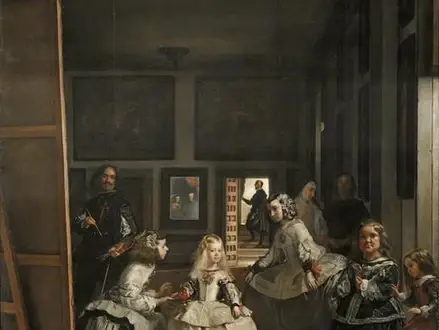Title of Artwork: “Las Meninas”

Artwork by Diego Velázquez
Year Created 1656
Summary of Las Meninas
The Ladies-in-Waiting (Spanish pronunciation: [las meninas]) is a 1656 painting by Diego Velázquez, one of the most prominent figures of Spain’s Golden Age. When looking at this piece, the viewer is left wondering whether or not they’re seeing what they think they’re seeing. In Western art, Las Meninas is one of the most frequently studied works.
According to some commentators, the painting depicts a large room in the Royal Alcazar of Madrid during King Philip IV’s reign and depicts several figures, most of whom are identifiable from the Spanish court, in a particular moment, as if captured in a photograph. Some of the figures stare directly at the observer, while others engage in conversation with one another. She is surrounded by her entourage of maids of honour, her bodyguard, her bodyguard’s two dwarf companions and a dog. Velázquez depicts himself working on a large canvas in the background. Rather than looking inside the painting, Velázquez looks outwards, to where a viewer stands. The king and queen’s upper bodies are reflected in a mirror in the background. However, some scholars have speculated that their image is reflected from the painting Velázquez is shown working on in the foreground of this painting.
All About Las Meninas
The painting Las Meninas has long been regarded as one of Western art history’s most significant works. Paintings by Luca Giordano and Sir Thomas Lawrence have been referred to as “theology of painting” and “the true philosophy of the art” by the Royal Academy of Arts presidents, respectively. Velázquez’s greatest achievement, a highly self-conscious, calculated demonstration of what painting could achieve, and perhaps the most searching comment ever made on the possibilities of easel painting, has been described in recent times.
The social status of painters was low in Spain in the 17th century. As a result, painting was considered a craft rather than an art form like poetry or music. As a result of his work in the court of Philip IV, Velázquez was promoted to palace chamberlain in February 1651. (aposentador mayor del palacio). For all its benefits, the position required a lot of time from him. Paintings of the royal family filled the last eight years of his life, with only a few more works to be completed. He had worked for the royal family for 33 years prior to painting Las Meninas.
First wife Elizabeth of France and only son Balthasar Charles died in 1644 and 1645, respectively. Because he had no heirs, Philip married Mariana of Austria in 1649 and had only one child, Margaret Theresa (1651–1673). When Charles (1661–1700) arrived, he became King Charles II at the age of three, succeeding his sister’s brother Philip Prospero (1657–1661). However, even though Philip resisted being depicted in old age, Velázquez included him in Las Meninas despite his objections. On his deathbed, Velázquez was given the Pieza Principal (“main room”) of the late Balthasar Charles’s residence, which had been converted into a palace museum. Las Meninas is filmed here. Philip had a chair in Velázquez’s studio where he could sit and watch the artist in action. The art-loving king appears to have had an unusually close relationship with the painter, despite strict etiquette. “I am crushed” was written by Philip in the margins of a memorandum on the selection of his successor following the death of Velázquez.
Information Citations
En.wikipedia.org, https://en.wikipedia.org/.
























